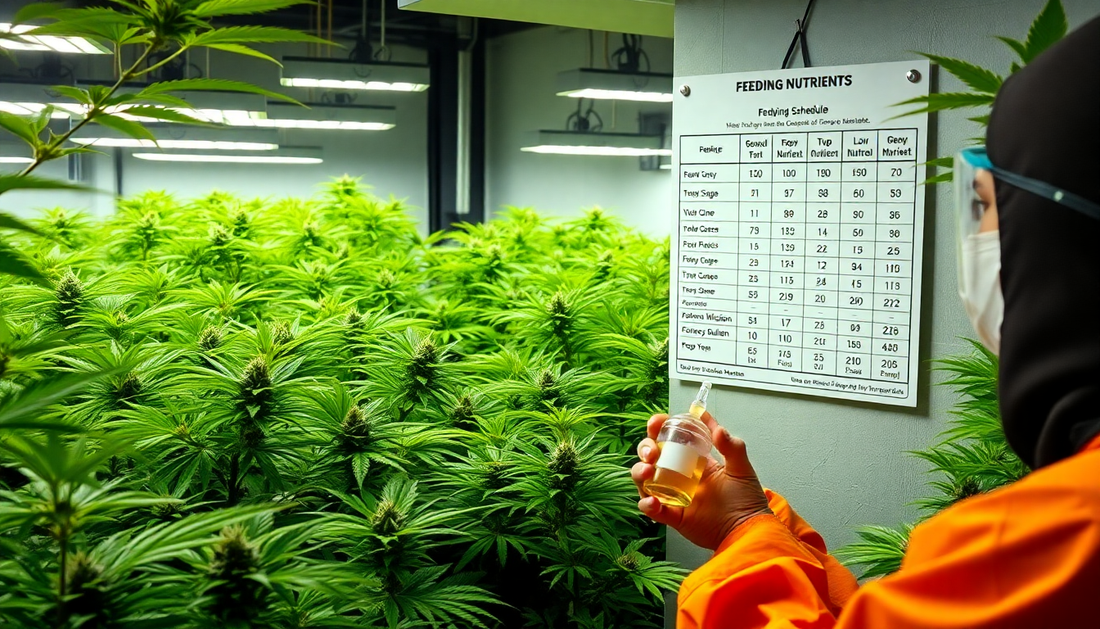
How Often to Feed Cannabis Plants Nutrients: A Complete Guide
Feeding your cannabis plants the right amount of nutrients at the right time is crucial for healthy growth and maximizing your harvest. While cannabis plants need a variety of nutrients throughout their life cycle, determining how often to feed them can be tricky, especially for new growers. Feed too often, and you risk nutrient burn; feed too little, and you may end up with deficiencies that stunt growth and reduce bud quality.
In this guide, we’ll explain how often you should feed nutrients to your cannabis plants during each stage of growth, how to recognize signs of overfeeding or underfeeding, and how to create an effective nutrient schedule.
Factors That Influence How Often to Feed Cannabis Nutrients
The frequency of nutrient feedings depends on several factors, including your growing medium, plant size, and the type of nutrients you use. Let’s break down these key factors:
1. Growing Medium
- Soil: Soil holds nutrients longer than other mediums, so cannabis plants grown in soil need to be fed less frequently. Feeding once every 7–10 days is often sufficient, depending on the quality of your soil.
- Coco Coir: Coco coir retains less nutrition than soil, so you’ll need to feed your plants more often—usually every other watering.
- Hydroponics: In hydroponic systems, nutrients are delivered directly to the roots through water, requiring frequent feedings—often every day or multiple times a day.
2. Type of Nutrients
- Liquid Nutrients: These are typically applied with every watering or every other watering, depending on the plant’s needs.
- Slow-Release Nutrients: Organic fertilizers like compost or super soil release nutrients gradually and require less frequent feeding.
3. Plant Size and Growth Stage
The nutrient requirements of cannabis plants change as they grow. Seedlings need minimal nutrients, while mature plants in the flowering stage demand more.
Nutrient Schedule by Growth Stage
Here’s a breakdown of how often to feed cannabis plants at each stage of growth:
1. Seedling Stage (Weeks 0–3)
During the seedling stage, cannabis plants are delicate and don’t require many nutrients. Overfeeding at this stage can easily cause nutrient burn and stunt growth.
- Feeding Frequency: None or very light feeding every 7–10 days.
- What to Use: Use a mild nutrient solution (25% strength) with a focus on nitrogen.
2. Vegetative Stage (Weeks 3–8)
The vegetative stage is when cannabis plants grow leaves, stems, and roots. This is a high-demand stage for nutrients, particularly nitrogen, which supports vigorous growth.
- Feeding Frequency: Feed every 7–10 days in soil or every other watering in coco coir. In hydroponic systems, feed with each watering.
- What to Use: A balanced nutrient solution with a higher nitrogen ratio (e.g., 3-1-2 NPK).
3. Early Flowering Stage (Weeks 8–10)
During the transition to flowering, cannabis plants reduce their nitrogen needs and start demanding more phosphorus and potassium to support bud development.
- Feeding Frequency: Feed every 7 days in soil or every other watering in coco coir. In hydroponic systems, continue feeding with each watering.
- What to Use: A flowering nutrient formula with a lower nitrogen content and higher phosphorus and potassium (e.g., 1-3-2 NPK).
4. Late Flowering Stage (Weeks 10–12+)
In the final weeks of flowering, cannabis plants require less nutrition. Reducing nutrients helps the plant focus on producing high-quality buds rather than new growth.
- Feeding Frequency: Feed every 10–14 days in soil or every third watering in coco coir. In hydroponic systems, reduce nutrient concentration.
- What to Use: A bloom booster with extra potassium to enhance bud density and resin production.
5. Final Week Before Harvest (Flush)
In the final week, it’s essential to stop feeding nutrients and flush your plants with pure water. This process removes excess nutrients, improving the flavor and smoothness of your buds.
- Feeding Frequency: None—flush with pH-balanced water for 7–14 days before harvest.
Signs of Overfeeding and Underfeeding
It’s important to monitor your plants for signs of nutrient issues and adjust your feeding schedule as needed. Here are common symptoms to watch for:
1. Overfeeding (Nutrient Burn)
Nutrient burn occurs when the plant receives too many nutrients. Symptoms include:
- Brown or yellow leaf tips
- Dark green foliage
- Crispy or curling leaves
Solution: Flush the growing medium with pH-balanced water and reduce the nutrient concentration.
2. Underfeeding (Nutrient Deficiency)
Nutrient deficiencies happen when the plant doesn’t receive enough nutrients. Symptoms include:
- Yellowing leaves (nitrogen deficiency)
- Purplish stems (phosphorus deficiency)
- Brown spots on leaves (calcium or magnesium deficiency)
Solution: Increase the frequency or concentration of your nutrient feedings.
How to Create a Cannabis Feeding Schedule
Creating a feeding schedule helps you stay consistent and avoid nutrient-related problems. Here’s how to build your own schedule:
1. Start with Manufacturer Guidelines
Most nutrient brands provide feeding schedules based on their products. Use these as a baseline and adjust based on your plant’s response.
2. Adjust for Growing Medium
Soil growers can reduce feeding frequency, while coco coir and hydroponic growers will need to feed more often.
3. Monitor and Adapt
Always observe your plants for signs of nutrient issues and adjust your schedule accordingly. Keep a journal to track feeding times and plant health.
Conclusion
How often you feed your cannabis plants nutrients depends on several factors, including the growing medium, plant stage, and type of nutrients you use. By following a consistent feeding schedule and monitoring your plants closely, you can avoid common nutrient issues and maximize growth and yield. Remember, it’s always better to start with a light feeding regimen and adjust as needed rather than risk overfeeding your plants.
